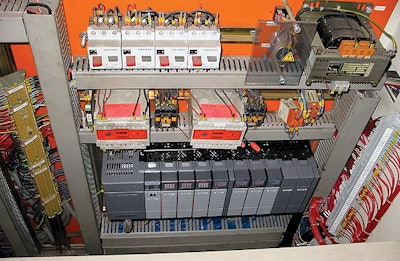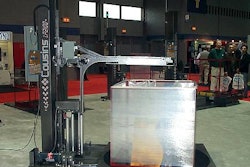It’s likely that Truitt Bros., a Salem, OR, fruit and vegetable canner, isn’t the only company operating tray packing equipment that’s more than 20 years old. In fact, its line—tray former, film overwrapper, and heat tunnel—remains a workhorse for the canner. A recent upgrade of its control system keeps that machine in regular operation.
Although the company had become skillful at maintaining the mechanical parts of the equipment, its control system remained a mystery to Truitt’s electricians. In part, that was because the equipment was built in Germany, and some of the controls documentation was presented in German, not English.
Still, until about a year ago, the equipment performed well. That’s when a glitch arose in tray handling at the stacking station: two correctly stacked trays were not released into the film wrapper, so the next tray crashed into them, creating a jam that required manual removal of cans and trays. At first, it was an infrequent problem, but not one that could be anticipated.
Electrical supervisor Greg Archibald suspected a programming defect. “We couldn’t do much maintenance on the control system, especially the programming, so we couldn’t even identify where the problem might be,” he says. “In addition, we were having greater difficulty in getting replacement parts.”
However, what really worried Archibald was when he heard about another food processor that had a PLC failure. “That company really scrambled to find another processor for its machine—all the while the machine was down. When we realized that our machine and processor was about the same vintage, we really became concerned,” Archibald recalls.
Networking solution
It turned out that Archibald had hired an electrician for some help, and he had worked with Concept Systems in the past. He recommended them for this assignment, and Archibald later discovered that the systems integrator had worked with other controls facilitators that Archibald had confidence in.
“We were asked for a controls solution that wouldn’t interrupt the machine operation and that wouldn’t require any retraining of operators,” says Ed Diehl of Concept Systems. “Essentially, the company wanted our fix to be as invisible as possible to the production people.”
The company specified Allen-Bradley from Rockwell Automation because it has that platform on several newer machines. So Concept Systems specified the SLC 5/04. It’s a small logic controller that was more than adequate to do the job on this machine. It’s just a smaller version of Allen-Bradley’s PLC 5. “It’s not a new system, but it’s one we know will be supported for many years to come,” Diehl says.
Concept Systems is a controls integrator that has achieved status as a Solutions Provider from Rockwell. “We reviewed what we knew of the existing program. By watching the operation of the machine, we knew functionally what the machine did and how it did it,” Diehl says. “Through this process, we figured out what was wrong with the existing logic that was creating the jamming. So, from scratch, we wrote a completely new program.”
It supplied the SLC on a blank panel with terminal distribution, and it made it physically the same size as the PLC it was replacing. “So we were able to insert it and to reuse all of the existing wiring,” Diehl says. In addition, the integrator provided new updated documentation for the programming. “We actually translated some of the former documentation that had been done in German,” he says with satisfaction.
“Their staff was very familiar with the machine and knew how to keep it running,” he says. “But controls and programming was an area of real weakness. If they had experienced a controls hardware failure, that machine would simply have been down because it’s all obsolete and unavailable.”
Weekend installation
To virtually eliminate downtime, most of the installation of the new control system was accomplished over a weekend in January ’04. Truitt Bros. began to talk with Concept Systems last November, and once a contract was signed, the software program was developed in December.
“We scheduled some weekend downtime, and I started on a Friday afternoon by taking out the old system,” Archibald recalls. “On Saturday, I put the new SLC in and Concept Systems came in Sunday for programming and debugging. Then they came back in on Monday for start-up. And it took right off.”
In total, Archibald reports that the new system has eliminated its case-packing and wrapping problems by 95%. “We may have done some mechanical work on it since, but I haven’t done any electrical or electronic repair since the new controls were put in.”
The entire project was completed for about $20ꯠ. It allows Truitt to keep a $200ꯠ machine operating efficiently. Payback is estimated at one year or less. The most visible part of that is that Truitt has been able to reassign the person who was stationed at the stacker to clear jams. “That tells you how often we were experiencing the problem,” says Archibald. “So now we’ve freed up one worker and made him happier because clearing the machine wasn’t a fun job.”
It’s also a bit of a first at the company. “Like most smaller companies, almost all of our maintenance is reactive, ‘putting out fires.’ We run machines, they break, and we fix them. This project was proactive or preemptive, which is not typically the way we operate. But we didn’t want to be down for weeks, which is what we’ve heard other companies experience if they wait to make the upgrade. It’s one reason why we’ve got Concept Systems looking at another controls project for us.”

























